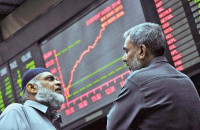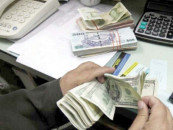Rupee to average at 163 against dollar in 2020: Fitch
Fitch expects downtrend to continue due to growing foreign debt, anticipated inflationary pressure

The Pakistani currency is anticipated to maintain its downward trend against the US dollar and other world major currencies in the short to long-run due to growing foreign debt and anticipated inflationary pressure.
“We forecast the unit (rupee) to continue to trade weaker, forecasting the rupee to average Rs163/US dollar in (calendar year) 2020," Fitch Solutions, the global research house and a sister firm of the Fitch credit rating agency, said in a report on ' EM Asia Currency Round-Up: Gains Ahead As Greenback Outlook Cools.'
"Over the long-term, we forecast the Pakistani rupee to average weaker at Rs171.15/US dollar in 2021 due to higher structural inflation vis-à-vis the US," it added.
The country may face structural inflation due to prevailing low benchmark interest rate at 25-month low of 7% at present compared to 13.25% in March and money printing to meet budgeted expenditures mainly on health and socio-economic fronts.
In April, the government launched relief and stimulus packages worth Rs1.2 trillion ($8 billion) in an effort to revive economic activities and limit job cuts in the past Covid-19 era.
Soft demand for Pakistani assets by foreign investors will continue to cool demand for the rupee, it said.
The depreciation would be gradual rather than sharp and sudden with likely backing from the government.
"Policymakers will likely allow for some depreciation, given lower (international petroleum) oil prices should cap inflationary pressures," it said. "We do not expect a sharper depreciation in the rupee given our expectation for support from international partners, such as the Global-20 countries, which will boost Pakistan’s foreign exchange reserve base and ease external financing pressures."
The international petroleum oil price hovers around $40 per barrel these days compared to over $60 per barrel in February, while G20 countries have rescheduled Pakistan debt repayment beyond December 2020.
The global research house commented on eight currencies belonging to the Asian emerging market (EM) in the report. Besides, a graph showed Pakistani currency as the biggest loser among 11 regional currencies in the past six-and-half-month.
"The Pakistani rupee has weakened around 7.1% in the year-to-date (since January) against the US dollar," it said. "The Pakistan rupee has underperformed given fears over its debt sustainability."
The growing government expenditures on health and socio-economic fronts, and likely second round of relief and economic stimulus packages may further pile up local and foreign debt and impact rupee-dollar parity.
Accordingly, "We also see risks from Pakistan’s fiscal position and an overshooting of its fiscal deficit target in fiscal year 2020-21," it said.
The government has targeted fiscal deficit at 7% compared to Fitch’s anticipation of 8.2% in FY21, according to a previous report.
The graph showed four countries' (ie Philippine, Taiwan, Japanese and Hong Kong) currencies appreciated; Vietnamese currency stayed unchanged; while Chinese, Indonesian, Thailand, Malaysian, Indian and Pakistani currencies depreciated since January (in the post Covid-19 period).
Fitch found a connection between the currencies' appreciation and depreciation with respective countries' efficient and inefficient lockdowns imposed to contain the coronavirus pandemic, except for Philippines.
"We can also not rule further stimulus measures and policymakers seeking to depreciate their respective currencies to boost export competitiveness," it said.
The Asian Dollar Index bottomed-out in March and is on recovery path with some volatility, another graph exhibited.
"Over the coming quarters, we expect the US dollar to weaken as bearish drivers emerge for the unit, and this could happen sooner than we think should the US dollar directly break support. EM Asia stands well placed to make further gains over the coming quarters in these conditions, given the easing of external financing conditions and their exposure to the Chinese economic recovery. Nevertheless, headwinds remain given the risk of further outbreaks of the coronavirus forcing the re-imposition of confinement measures and an intensification of the US-China trade war and broad West-China tensions."



















COMMENTS
Comments are moderated and generally will be posted if they are on-topic and not abusive.
For more information, please see our Comments FAQ